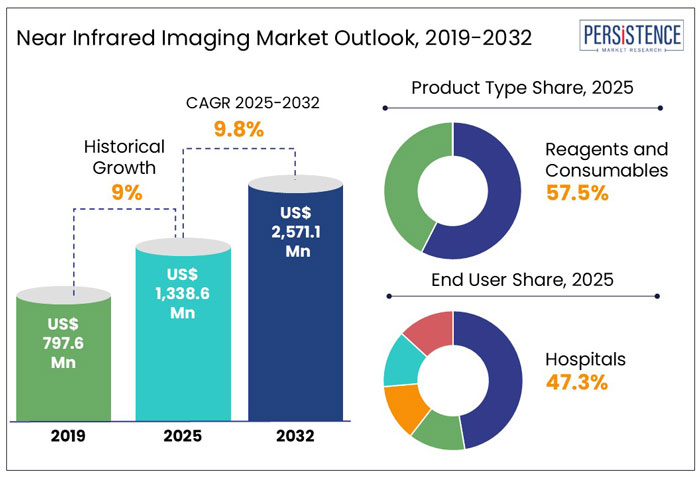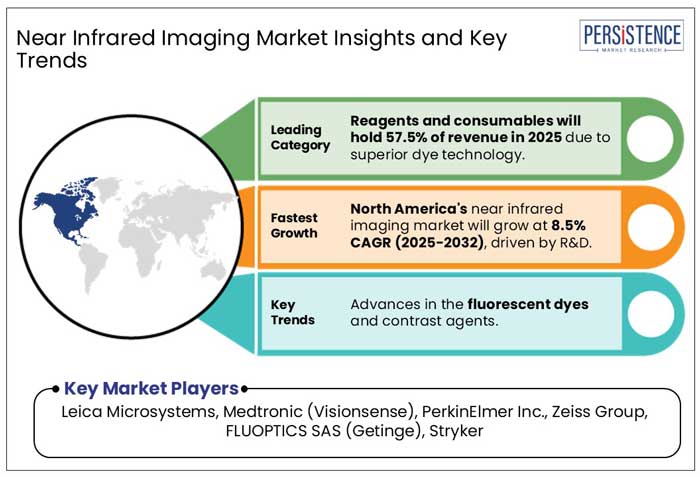Industry: Healthcare
Published Date: March-2025
Format: PPT*, PDF, EXCEL
Delivery Timelines: Contact Sales
Number of Pages: 186
Report ID: PMRREP35177
The global near infrared imaging market size is anticipated to rise from US$ 1,338.6 Mn in 2025 to US$ 2,571.1 Mn by 2032. It is projected to witness a CAGR of 9.8% from 2025 to 2032. With its ability to visualize tissues, blood flow, and tumors in real-time, near infrared imaging is transforming minimally invasive surgery, oncology, and ophthalmology.
NIR imaging assists in cancer detection, with fluorescence-guided surgery improving tumor removal accuracy by 30%. It is also critical in vascular surgeries and neurology, reducing post-surgical complications.
As healthcare shifts toward AI-integrated imaging, NIR technology ensures higher accuracy, reduced recovery time, and better patient outcomes, making it a game-changer in medical diagnostics.

Key Highlights of the Near Infrared Imaging Market
|
Global Market Attributes |
Key Insights |
|
Near Infrared Imaging Market Size (2025E) |
US$ 1,338.6 Mn |
|
Market Value Forecast (2032F) |
US$ 2,571.1 Mn |
|
Projected Growth (CAGR 2025 to 2032) |
9.8% |
|
Historical Market Growth (CAGR 2019 to 2024) |
9.0% |
Rising Prevalence of Cancer and CVDs Supports the Integration of Advanced Diagnostic Imaging Technologies
As per Persistence Market Research, the global near infrared imaging industry witnessed a CAGR of 9.0% in the historical period between 2019 and 2024. The increasing burden of cancer and cardiovascular diseases (CVDs) has driven demand for advanced diagnostic imaging technologies, including NIR imaging.
In the observed period, over 19.3 million new cancer cases were reported annually, with 60% affecting individuals aged 50 and older. Similarly, CVDs account for 17.9 million deaths yearly, with over 75% of patients aged 65+ undergoing vascular interventions.
NIR imaging-assisted surgeries have risen by 35% due to their high precision in tumor resection and blood flow visualization. In 2023 alone, 1.2 million NIR-assisted surgeries were performed worldwide, with a success rate exceeding 90%.
As cancer and heart disease cases continue to rise, hospitals and diagnostic centers are rapidly integrating AI-enhanced NIR imaging systems to improve early detection, treatment accuracy, and surgical success rates.
Advances in the Fluorescent Dyes and Contrast Agents Improve Imaging Sensitivity Through 2032
In the estimated timeframe from 2025 to 2032, the global market for near infrared imaging technologies is likely to showcase a CAGR of 9.8%. The development of next-generation contrast agents, which are intended for targeted molecular imaging and improve imaging sensitivity and diagnostic accuracy, is anticipated to propel the demand for fluorescence imaging agents.
Innovations such as near infrared fluorophores, like Indocyanine Green (ICG) and Cy5.5, are expected to enhance tumor detection and real-time surgical navigation with 98% sensitivity in cancer diagnostics.
In 2024, over 1.5 million NIR-guided procedures were conducted worldwide, highlighting its growing adoption in oncology, neurology, and cardiovascular imaging. Advanced photoacoustic contrast agents are also emerging, offering higher tissue penetration and reduced toxicity.
AI-powered fluorescence lifetime imaging (FLIM) is set to revolutionize disease monitoring, enabling early-stage cancer detection with 30% greater precision. As these innovations continue, fluorescent imaging will play a crucial role in precision medicine and minimally invasive diagnostics in the coming years.
Adoption of NIR Imaging Beyond Surgery Presents Opportunities for Innovation
The growing use of NIR imaging in non-invasive medical diagnostics is opening new market opportunities beyond traditional surgical applications. The use of NIR imaging in neurology, dermatology, and cardiovascular diagnostics is driving the market's expansion globally. Unlike conventional imaging, NIR offers high tissue penetration, real-time visualization, and reduced radiation exposure, making it ideal for early disease detection.
In 2024, over 5 million NIR-based diagnostic tests were conducted worldwide, with cardiovascular and neuroimaging applications growing in the healthcare industry. AI-enhanced NIR imaging is improving functional brain mapping and tumor detection, offering 98% accuracy in early-stage cancer diagnostics.
The demand for point-of-care and telemedicine applications is expanding as healthcare moves toward preventative diagnoses due to the integration of NIR imaging into portable devices for real-time monitoring of oxygen saturation, wound healing, and metabolic diseases.
High Maintenance Prices Hampers the Widespread Adoption of Infrared Thermography
The high cost of infrared thermography technology prevents them from being widely used in healthcare. NIR imaging systems cost between US$ 30,000 and US$ 150,000, whereas typically cooled detectors can cost up to US$ 250,000, limiting accessibility.
Annual maintenance, calibration, and software updates add 15% to 20% to the total cost of ownership. The need for specialized personnel for operating and interpreting NIR imaging results further raises operational costs. Despite the benefits of real-time, radiation-free diagnostics, only 30% of healthcare facilities in developing regions have adopted NIR imaging due to financial constraints.
The extensive use of NIR technology is restricted by high costs for research and development, which are anticipated to be US$ 3 Bn worldwide each year. These expenses hinder breakthroughs and postpone cost reductions, especially in small and mid-sized healthcare facilities.
Surge in Research and Development in Targeted Molecular Imaging Magnifies Clinical Applications
Increasing research and development in targeted molecular imaging is projected to reshape disease detection and treatment planning. Molecular imaging allows for precise visualization of biological processes at the cellular level, enabling early diagnosis of cancer, cardiovascular diseases, and neurodegenerative disorders.
The development of targeted fluorescent probes has improved the sensitivity and specificity of near infrared imaging, allowing 97% accuracy in detecting tumor margins during oncological surgeries. In cardiovascular applications, targeted PET tracers help identify atherosclerotic plaque formation before symptoms appear, reducing cardiovascular event risks by 40%.
The use of molecular contrast agents such as indocyanine green and fluorescent nanoparticles has increased Alzheimer's disease detection rates by 30%, due to FDA approvals and a growing need for precision treatment.
Rising Adoption of Reagents and Consumables in Spinal Surgeries Provide Better Results
The reagents and consumable segment, which is projected to account for 57.5% of the market in 2025, is expanding due to its superiority over traditional visible-light dyes. Indocyanine Green is the leading reagent in this segment, widely used for real-time angiographic imaging during brain tumor resections, vascular surgeries, and spinal procedures. The adoption of ICG in spinal surgery enhances intraoperative perfusion assessment, reducing postoperative complications by 40%.
The demand for fluorescent contrast agents has surged, with ICG applications increasing by 35% since 2020, particularly in oncology, cardiology, and neurosurgery. Studies show that ICG-based angiography improves vascular visualization by 90%, aiding in precise surgical decision-making.
The next-generation near infrared fluorophores, such as IRDye 800CW and fluorescein sodium, are expanding the demand for reagents by providing higher tissue penetration and longer fluorescence duration. With continued specialized advances and regulatory approvals, the reagents and consumables are set to witness sustained growth in diagnostic and surgical applications worldwide.
Use of Near Infrared Imaging in Hospitals Provides Accurate Outcome for Cataract
Hospitals are projected to dominate the near infrared imaging market, accounting for 47.3% of total revenue in 2025. This growth is fueled by the increasing prevalence of cancer, cardiovascular diseases, and complex surgical procedures.
NIR imaging is widely used in hospitals for bed sore detection, intraoperative fluorescence-guided surgery, and wound healing monitoring. Laparoscopic devices equipped with NIR sensors improve surgical precision, reducing complications like accidental blood vessel cuts by 32%. Additionally, the adoption of minimally invasive surgeries (MIS) has risen by 40% since 2019, increasing demand for NIR-assisted visualization in real-time diagnostics.
Hospitals in developed regions like North America and Europe are investing in advanced imaging technologies to enhance surgical accuracy, shorten hospital stays, and reduce postoperative healthcare costs, solidifying their leadership in the NIR imaging market.

North America Emerges as Research and Development Hub for Advanced Treatment
In 2025, the near infrared imaging market in North America is anticipated to attain a market share of 39.1%. The growth is driven by significant investments in biomedical research, particularly in the U.S. and Canada, where NIR imaging is increasingly used to study cell metabolism, tumor progression, and neurodegenerative disorders. The NIR market in North America is projected to record a CAGR of 8.5% from 2025 to 2032.
U.S.-based companies such as PerkinElmer, Bruker Corporation, and LI-COR Biosciences are pioneering fluorescence-guided surgeries and targeted molecular imaging using NIR dyes like ICG. The expansion of cancer diagnostics and minimally invasive surgeries in North America is anticipated to boost demand in the projected period.
Research collaborations between Harvard Medical School and MIT focus on real-time NIR imaging for precision medicine, ensuring continued market leadership and technological innovation in biomedical imaging.
Rise in Minimally Invasive Procedures in Europe Fuels the NIR Imaging Applications
In Europe, the increasing adoption of minimally invasive procedures is fueling demand for non-invasive imaging techniques such as NIR imaging. With over 4.5 million minimally invasive surgeries performed annually across the region, hospitals and research institutions are integrating advanced optical imaging solutions to enhance surgical precision and patient safety.
The European Society of Radiology (ESR) reported a 20% increase in demand for real-time intraoperative imaging in 2024, in oncology, neurology, and cardiovascular surgeries. Countries such as Germany, France, and the U.K. are investing heavily in NIR imaging for fluorescence-guided tumor resection and vascular imaging.
The European Commission’s Horizon Europe program has allocated US$ 1.5 Bn for medical imaging innovations, accelerating the adoption of non-invasive diagnostic tools and reinforcing Europe’s position as a leader in medical imaging advancements.
Growing Patient Pool of Asia Pacific Caters Demand for NIR Imaging
The near infrared imaging market in Asia Pacific is poised to expand, driven by a growing geriatric population and an increasing need for affordable diagnostic solutions. Countries like China, India, and Japan collectively account for over 700 million elderly individuals, with age-related conditions such as cancer, cardiovascular diseases, and neurodegenerative disorders becoming more prevalent.
China and India, in particular, are investing in low-cost, high-efficiency imaging solutions to cater to their vast populations. Japan, a leader in medical technology, has seen a 25% rise in the adoption of NIR-guided surgeries in oncology and vascular procedures since 2022.
Government initiatives, such as India’s National Digital Health Mission (NDHM), are envisioned to accelerate the adoption of cost-effective imaging solutions, making Asia Pacific a high-growth market for NIR imaging technologies.
Several major competitors are aggressively expanding their market position through strategic efforts in the quickly changing global near infrared imaging market. Since these businesses are making large investments in research and development, it is anticipated that their products will advance and become more widely available. These companies are keeping a close watch on technical progress and are working to improve their goods to include the most recent developments.
Establishing alliances and collaborations, expanding geographically, and introducing new goods are some of the methods being pursued by the top corporations to support their success. Strategic acquisitions are also being considered in order to strengthen their positions in this competitive environment and meet the growing need for advanced imaging solutions.
|
Report Attributes |
Details |
|
Historical Data/Actuals |
2019 - 2024 |
|
Forecast Period |
2025 - 2032 |
|
Market Analysis Units |
Value: US$ Bn/Mn, Volume: As applicable |
|
Geographical Coverage |
|
|
Segmental Coverage |
|
|
Competitive Analysis |
|
|
Report Highlights |
|
|
Customization and Pricing |
Available upon request |
By Product
By Procedure
By Application
By End User
By Region
To know more about delivery timeline for this report Contact Sales

The market is set to reach US$ 25.15 Bn in 2025.
The future of IR imaging is promising due to advancements in resolution, sensitivity, and AI integration. Such improvements enable applications in medical diagnostics, environmental monitoring, and industrial inspections.
Leica Microsystems, Medtronic (Visionsense), PerkinElmer Inc., and Zeiss Group are a few leading players.
The industry is estimated to rise at a CAGR of 6.7% through 2032.
North America is projected to hold the largest share of the industry in 2025.